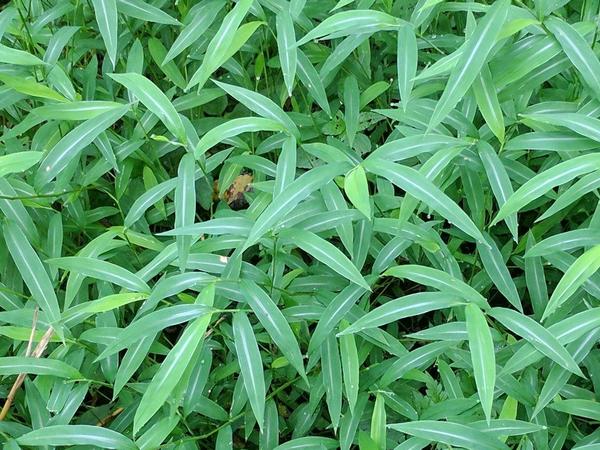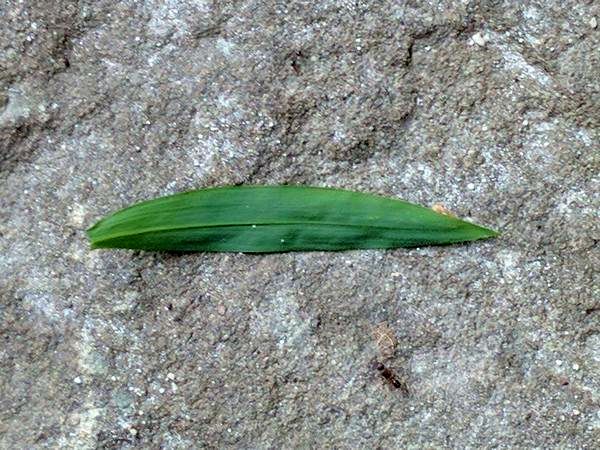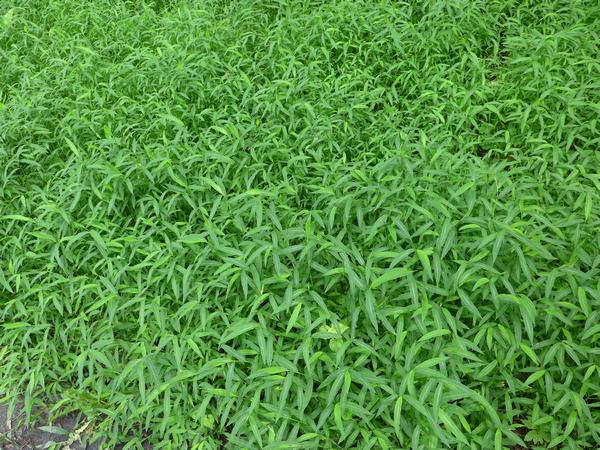
This summer I’ve found a lot of stiltgrass in western Pennsylvania.
Japanese stiltgrass (Microstegium vimineum) is a native of Eurasia that grows in both sun and shade. In the 1900s it was used as packing material for shipping porcelain from China to the New World. Inevitably, it took root in Tennessee in 1919 and is now present in 24 states and Puerto Rico. In Pennsylvania it’s invasive, especially in the woods.
Though grasses are notoriously difficult to identify, stiltgrass has three characteristics that help you figure it out.
(1) Each leaf has a shiny central rib, as shown above.
(2) The rib is off center on the leaf, easiest to see on the underside.

(3) Unlike native grasses, stiltgrass forms a dense carpet on the forest floor that chokes out all other plants.

When you see dense grass like this, check it for shiny off-center ribs. Watch this video for more identification clues.
This year I’ve seen stiltgrass at all the bike trails and even in the woods in Schenley Park. It looks like a nice carpet until you realize it’s invasive. It’s everywhere!
How do you get rid of it?
Deer don’t eat it. But goats do. Hmmmm.
(photos by Kate St. John)
Hi Kate it is easy to pull and does not seed until late summer so pulling it may slowly make a difference.. I’ve been pulling it in my yard a few minutes a day since identifying it a couple years back; it showed up after I took out my Japanese pachysandra to make way for jewelweed and clearweed – think it’s starting to help….
Stiltgrass is unusually difficult to get rid of, forest management techniques (such as controlled burns) just ‘make it mad’ and the plant responds by growing faster! It can also take root from the nodes along its stem (hence the carpet effect). By pulling it in late summer (when it is tall but before it sets seed) and then re-seeding the area with native plants, you might be able to make progress (pull while the soil is moist, if you tear the roots it will sprout with vigor). It likes cool, moist areas, so opening up the upper canopy (trimming back some tree branches) and not watering it might help too. Be prepared to fight it for years, even though it dies back over the winter, the seeds from previous years can survive in the soil for years, just waiting for cool, moist conditions to occur so it can sprout up and race over the area.
Hi Kate,
I came upon your blog while looking for pictures of Japanese stiltgrass. It’s for a book on weeds… Would you be able to get in touch? I am in England and it is not a thing here yet.
Thank you!
When is the best time to mow it and how high or ( low ) should one mow.
I’m assuming that mowing the early ( and or late ? ) stalk while it’s still
forming flower / seed is a good idea.
Mike, See Susan King’s comment above at https://www.birdsoutsidemywindow.org/2017/08/06/stiltgrass-is-everywhere/#comment-202465
It is very hard to get rid of, but here are some tips from Penn State Extension Service:
https://extension.psu.edu/controlling-japanese-stiltgrass-in-your-garden.
Hi. Just found your site while looking for good photos to show anyone who might care. Which is, unfortunately, in our neck ‘o’ the woods, not many.
I’m in my 5th or 6th year now of dealing with this menace (now October 1, 2022.) No, it is not easy to get rid of. It took me a year or two to realize that the roots must be thoroughly exposed before pulling, because they’re not nearly as fragile as they may seem, & will regrow from the remaining root ends if you don’t get them all. I suppose this is mainly if you’re trying to get rid of them earlier in the year.
In this area, it has now spread almost everywhere, & we have seen it in every park we’ve visited, local, State & National. Some places it seems to have entirely taken over. We told the park officials about it, but nothing seems to have been done. I also used to painstakingly take photos to send to EDDMapS, but finally stopped when it seemed it didn’t actually help anything except keeping track of the invasion!
We realize we’ll have to deal with it every year, even though I clean it off our property & as much as the immediate neighbors as possible, constantly. At least it isn’t everywhere in our yard now. But the seeds must be able to blow in from elsewhere, because it still seems to crop up, especially near the road.
Until a truly motivated effort is made to inform the public and measures taken to eradicate this pest, it will continue to flourish. It’s especially sad that park officials (at least here) seem to care so little.